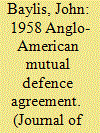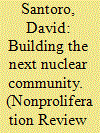| Srl | Item |
| 1 |
ID:
082242


|
|
|
|
|
| Publication |
2008.
|
| Summary/Abstract |
Written on the 50th anniversary, this article focuses on the negotiations between Britain and the United States which led to the 1958 Mutual Defence Agreement and the beginning of the 'special nuclear relationship' which has lasted down to the present day. It is argued that the eventual success of the negotiations had a lot to do with the key roles of Eisenhower and Macmillan but that a transatlantic 'advocacy coaltion' of nuclear scientists, defence and intelligence officials also played an important part at the operational level in achieving and subsequently shaping the kind of relationship which developed. Attention is also given to the longer term significance of the agreement, especially in terms of the arguments about its impact on nuclear proliferation.
|
|
|
|
|
|
|
|
|
|
|
|
|
|
|
|
| 2 |
ID:
162686


|
|
|
|
|
| Summary/Abstract |
This viewpoint takes stock of the changes in the strategic nuclear landscape in recent decades and reflects on its consequences on the policy community. It finds that the number and scope of issues have expanded considerably; they have manifested themselves in many more regions of the world; and they have become deeply politicized and polarized. The consequences have been twofold: the nuclear policy field has seen the development of an increasingly diverse expert community composed of highly specialized functionalists and regionalists, and it has become ever more divided into two entirely separate ideological camps—one that believes in deterrence, the other in disarmament. The stove-piping of expertise and the widening gap between deterrence and disarmament ideologies are immensely problematic because, in different ways, they stand in the way of the emergence of a better and safer nuclear future. Looking ahead, it is critical to “bust the silos of expertise” and to build bridges between the deterrence and disarmament ideological camps. Only such a community-building effort will help solve today’s and tomorrow’s nuclear challenges.
|
|
|
|
|
|
|
|
|
|
|
|
|
|
|
|
| 3 |
ID:
127131


|
|
|
|
|
| Publication |
2013.
|
| Summary/Abstract |
In January 1950 President Harry S. Truman announced that the United States would proceed with further work to determine the feasibility of a 'Super', or hydrogen, bomb. The events leading up to that decision - counter-pressures and advocacy from a number of quarters, including the divided Atomic Energy Commission (AEC), the nuclear scientists, Congress and the Pentagon - is well known. Less attention has been given to how the story of the Super came to be told in official and popular publications. Admiral Lewis L. Strauss, rogue member of the AEC, later presidential adviser on atomic affairs and AEC chairman, was one of the most vigorous advocates of developing thermonuclear weapons. He was also a highly skilled player of bureaucratic politics. This article draws upon the Strauss archives to examine how he used his position and his contacts to shape the history of the H-bomb to his own political advantage.
|
|
|
|
|
|
|
|
|
|
|
|
|
|
|
|
| 4 |
ID:
108722


|
|
|
|
|
| Publication |
2011.
|
| Summary/Abstract |
The study of the Cold War has undergone a significant transformation in recent years, with new critical perspectives, sources and debates. The nuclear history of the Cold War has begun to yield new insights on fundamental questions about the stability and dynamics of the confrontation. Recent evidence about the events of 1983 provides an opportunity to explore the risk of nuclear war and the role of misperception in Soviet-American relations during the 'Second Cold War'. Central to this is the study of intelligence. This article examines episodes in the autumn of 1983, notably the Able Archer 'crisis' of November 1983. Attention focuses on aspects of Soviet, American and British intelligence. Political and diplomatic consequences are also considered. A principal aim is to emphasize that we are at an early stage in researching and understanding events, and that a number of assumptions about the crisis require further exploration. Broader lessons about the role of intelligence in the Cold War are nevertheless explored and provisional conclusions reached about the performances of intelligence agencies and communities.
|
|
|
|
|
|
|
|
|
|
|
|
|
|
|
|
| 5 |
ID:
098716


|
|
|
| 6 |
ID:
057748


|
|
|
|
|
| Publication |
Nov 20, 2004.
|
|
|
|
|
|
|
|
|
|
|
|
|
|
|
|
| 7 |
ID:
099798


|
|
|
|
|
| Publication |
2010.
|
| Summary/Abstract |
From 1945 to 1949 the USA was the world's only nuclear power. Although the nuclear arsenal was overestimated both in terms of size and readiness by the US military in its war plans, atom bombs came to be seen as the essential counter to conventional Soviet forces. The USSR constructed its own bombs in turn, and for decades the analysis of nuclear deterrence was almost exclusively concerned with the two superpowers. In the twenty-first century, the nuclear world no longer displays that mirror-image symmetry and can now be viewed as unipolar, regional, multipolar or stateless. Nuclear deterrence that seemed such an established technical reality during the Cold War should be recognized as a psychological construct that depends on threat perception and cultural attitudes, as well as the values, rationality and strength of political leaders who themselves have to mediate between groups with vested economic or military interests. As the number of nuclear weapons states increases, the logic of nuclear deterrence becomes less obvious and it should not be casually invoked as a general security factor without regard to a specific context. Nuclear weapons have become emblems of geopolitical power under the guise of deterrence. We argue that nuclear deterrence is meaningless against extremist terrorists. Our survey of its quirks leads us to believe that nuclear deterrence is a far less foolproof and reliable global security mechanism than many assume.
|
|
|
|
|
|
|
|
|
|
|
|
|
|
|
|